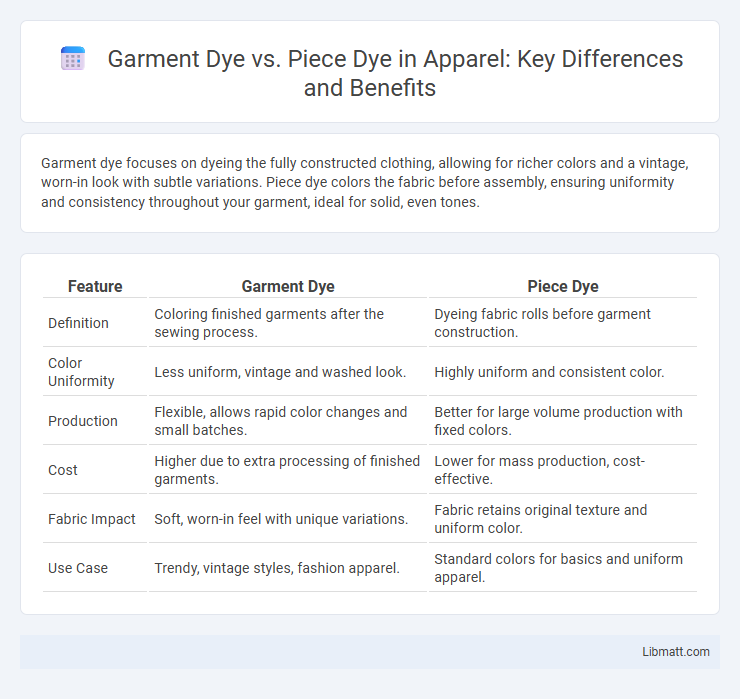Garment dye focuses on dyeing the fully constructed clothing, allowing for richer colors and a vintage, worn-in look with subtle variations. Piece dye colors the fabric before assembly, ensuring uniformity and consistency throughout your garment, ideal for solid, even tones.
Table of Comparison
| Feature | Garment Dye | Piece Dye |
|---|---|---|
| Definition | Coloring finished garments after the sewing process. | Dyeing fabric rolls before garment construction. |
| Color Uniformity | Less uniform, vintage and washed look. | Highly uniform and consistent color. |
| Production | Flexible, allows rapid color changes and small batches. | Better for large volume production with fixed colors. |
| Cost | Higher due to extra processing of finished garments. | Lower for mass production, cost-effective. |
| Fabric Impact | Soft, worn-in feel with unique variations. | Fabric retains original texture and uniform color. |
| Use Case | Trendy, vintage styles, fashion apparel. | Standard colors for basics and uniform apparel. |
Understanding Garment Dye and Piece Dye
Garment dye involves dyeing a fully constructed clothing item, allowing for unique color variations and a vintage look, while piece dye refers to dyeing the fabric before cutting and sewing, ensuring uniform color throughout. You should choose garment dye for a softer feel and varied hues, whereas piece dye is ideal for consistent color matching and precise design control. Understanding these processes helps in selecting the right method to achieve your desired garment aesthetics and quality.
Historical Background of Dyeing Techniques
Garment dye and piece dye represent two distinct dyeing techniques with roots tracing back to traditional textile practices; garment dye involves coloring fully assembled garments, a method gaining popularity in the late 20th century for its ability to produce unique, vintage effects. Piece dye, dating back to ancient civilizations, colors fabric in its raw form before garment construction, allowing for consistent and uniform coloration widely preferred in mass production. Both techniques reflect evolving industrial innovations aimed at enhancing fabric aesthetics and consumer appeal.
The Garment Dye Process Explained
The garment dye process involves dyeing fully constructed garments rather than individual fabric pieces, allowing for rich, uniform color and a soft, worn-in feel. This method enhances color vibrancy and depth, adapting well to varied fabric blends and pre-washed textiles. Unlike piece dyeing, garment dyeing offers more flexibility for last-minute color changes and results in unique, vintage-style garments with subtle shading variations.
The Piece Dye Method Unveiled
The Piece Dye method involves dyeing fabric after it is woven, allowing for precise color control and consistent dye penetration. This technique ensures durability and uniformity across the entire textile, making it ideal for mass production of garments requiring standardized hues. Compared to Garment Dye, Piece Dye provides enhanced colorfastness and minimal fabric distortion during the dyeing process.
Key Differences Between Garment Dye and Piece Dye
Garment dye involves coloring the finished garment, allowing for unique, vintage-style effects and subtle color variations, while piece dye colors fabric before it is cut and sewn, ensuring uniform color throughout. Garment dye offers flexibility in production with quicker response times to fashion trends, whereas piece dye provides color consistency ideal for large-scale manufacturing. Differences in fabric handling during dyeing affect texture and shading, making garment dye preferred for casual wear and piece dye typical for formal or uniform apparel.
Color Consistency and Variation
Garment dyeing often results in unique color variations and a vintage look due to dyeing the finished garment, which can create subtle inconsistencies ideal for a customized aesthetic. Piece dyeing ensures superior color consistency by dyeing fabric rolls before garment assembly, providing uniform shades across your entire collection and meeting strict quality standards. Choosing between the two depends on whether your priority is consistent color matching or distinctive, varied hues.
Impact on Fabric Texture and Feel
Garment dyeing alters the fabric's texture by softening fibers and creating a lived-in, vintage feel that enhances comfort and flexibility. Piece dyeing maintains a more uniform and consistent texture, preserving the fabric's original feel and structure. Your choice between garment dye and piece dye affects how the fabric interacts with wear and washing, influencing long-term softness and appearance.
Durability and Colorfastness Comparison
Garment dyeing typically results in softer fabric with a unique, vintage look but may have lower durability and colorfastness due to dyeing after construction, leading to a higher risk of uneven fading and wear. Piece dyeing, where fabric is dyed before garment assembly, offers superior colorfastness and durability because the fibers absorb dye uniformly, ensuring consistent and long-lasting color retention. Your choice between garment dye and piece dye affects how well your clothing maintains its appearance and withstands washing over time.
Sustainability and Environmental Factors
Garment dyeing reduces water and energy consumption by dyeing finished products rather than fabrics, leading to less waste and a smaller carbon footprint. Piece dyeing allows for bulk fabric processing but typically involves higher water use and chemical discharge, impacting sustainability negatively. Your choice influences the environmental footprint, with garment dyeing often considered a more eco-friendly option in textile production.
Choosing the Right Dyeing Technique for Your Needs
Selecting the appropriate dyeing technique depends on the desired fabric appearance, colorfastness, and production timeline. Garment dyeing offers vibrant, vintage-inspired hues with slight color variations, ideal for fashion-forward or limited-edition pieces. Piece dyeing ensures consistent, uniform color across large fabric volumes, making it suitable for mass production and standardized color requirements.
Garment Dye vs Piece Dye Infographic

 libmatt.com
libmatt.com